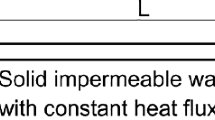Abstract
The critical issues are examined in the application of constant-temperature hot-wire anemometry to hypersonic boundary layers. While continuous turbulence measurements are more challenging to make in hypersonic flows, it is shown here that the difficulties can be overcome for a wide range of flow conditions. An extensive review of the literature reveals that many of the heat transfer complexities associated with hypersonic anemometry have already been resolved. Frequency-response tests, calibration results and boundary-layer measurements in hypersonic flow are also presented. A hot-wire frequency response of about 500 kHz was obtained in a Mach 11 flow, and the resulting boundary-layer spectra are smooth and repeatable.
Similar content being viewed by others
Abbreviations
- D :
-
hot-wire diameter
- E :
-
instantaneous anemometer voltage
- f, g :
-
functions of the overheat ratio,τ
- f r :
-
hot-wire frequency response
- g(s) :
-
dimensionless function of the molecular speed ratio
- k :
-
thermal conductivity coefficient
- l :
-
active length of the hot-wire element
- Kn :
-
Knudsen number (Kn = λ/D)
- n :
-
exponent of theNu-Re relation for a hot wire
- Nu :
-
Nusselt number
- Pr :
-
Prandtl number
- R :
-
electrical resistance
- R 1 :
-
resistance of the anemometer bridge leg in series with the wire
- Re :
-
Reynolds number based on the hot-wire diameter
- s :
-
molecular speed ratio\(\left( {{u \mathord{\left/ {\vphantom {u {V_{mp} }}} \right. \kern-\nulldelimiterspace} {V_{mp} }} = \sqrt {\frac{\gamma }{2}M} } \right)\)
- t :
-
shock thickness
- T e :
-
wire recovery temperature
- U :
-
freestream velocity
- V mp :
-
most-probable molecular speed
- α :
-
thermal accommodation coefficient
- δ :
-
boundary layer thickness or shock detachment distance
- η :
-
recovery factor (η ≡T e /T 0) or Kolmogorov length scale
- λ :
-
mean free path
- ϱ :
-
density
- τ :
-
hot-wire overheat ratio (τ ≡ (T w −T e /T 0)
- e :
-
boundary-layer edge value
- w :
-
wire value
- ∞:
-
freestream condition
- 0:
-
stagnation condition
References
Baldwin LV;Sandborn VA;Laurence JC (1960) Heat transfer from transverse and yawed cylinders in continuum, slip, and free molecule air flows. J Heat Trans 82: 77–86
Beckwith IE (1959) Similar solutions for the compressible boundary layer on a yawed cylinder with transpiration cooling. NASA TR R-42
Bonnet JP;de Roquefort TA (1980) Determination and optimization of frequency response of constant temperature hot-wire anemometers in supersonic flows. Rev Sci Instrum 51: 234–239
Cole J; Roshko A (1954) Heat transfer from wires at Reynolds numbers in the Oseen range. Proc Heat Transfer Fluid Mech Inst, Univ. Cal. Press, pp 13–23
Dewey CF (1961) Hot wire measurements in low Reynolds number hypersonic flows. J Amer Rocket Soc 28: 1709–1718
Fernando EM (1988) Supersonic turbulent boundary layer in an adverse pressure gradient. Ph.D. Thesis, Department of Mechanical and Aerospace Engineering, Princeton University
Hayes WD; Probstein RF (1966) Hypersonic flow theory. Academic press.
Jones RA; Williams VF (1970) Preliminary surveys of the wall boundary layer in a Mach 6 axisymmetric tunnel. NASA TN D-562
Kistler AL (1959) Fluctuation measurements in a supersonic turbulent boundary layer. Phys of Fluids 2: 290–296
Kovaśznay LSG (1950) The hot-wire anemometer in supersonic flow J Aeronautical Sciences 17 pp: 565–573
Kovásznay LSG (1954) Development off turbulence-measuring equipment. NACA Report 1209
Laufer J;McClellan R (1956) Measurements of heat transfer from fine wires in supersonic flows. J Fluid Mech 1: 276–289
Liepmann HW; Roshko A (1957) Elements of gasdynamics, GALCIT Aeronautical Series, John Wiley & Sons
Morkovin MV (1956) Fluctuations and hot-wire anemometry in compressible flows. AGARDograph 24
Morkovin MV (1962) Effects of compressibility on turbulent flows. Intl Symposium on the Mechanics of Turbulence, A. Favre, Ed., CNRS, Paris, pp 367–380
Perry AE;Smits AJ;Chong MS (1979) The effects of certain low frequency phenomena on the calibration of hot-wires J Fluid Mech 90: 415–431
Smits AJ;Hayakawa K;Muck KC (1983) Constant-temperature hot wire anemometer practice in supersonic flows — Part 1: The Normal Wire. Exp in Fluids 1: 83–92
Smits AJ; Dussauge J-P (1989) Hot-wire anemometry in supersonic flow. In AGARDograph AG-315, Chapter 5
Smits AJ (1990) An introduction to hot-wire anemometry in supersonic flows. Symp. on the Heuristics of Thermal Anemometry, 1990 ASME FED Meeting, Toronto
Spina EF;Donovan JF;Smits AJ (1991) On the structure of high-Reynolds-number supersonic turbulent boundary layers. J Fluid Mech 222: 293–327
Stalder JR; Goodwin G; Creager MO (1951a) A comparison of theory and experiment for high-speed free-molecule flow. NACA Report 1032
Stalder JR; Goodwin G; Creager MO (1951b) Heat transfer to bodies in a high-speed rarefied-gas stream. NACA TN 2438
Watson RD; Bushnell DM (1971) Calibration of the Langley Mach 20 high Reynolds number helium tunnel including diffuser measurements. NASA TM X-2353
Watson RD (1978) Characteristics of Mach 10 transitional and turbulent boundary layers. NASA TP-1243
Wyngaard JC (1968) Measurements of small-scale turbulence structure with hot wires. J Phys E: Sci Instr 1: 1105
Author information
Authors and Affiliations
Additional information
The work of the first author was supported by NASA-Langley Grant NAG-1-1400, under the supervision of Dr. Stephen K. Robinson. The assistance of Mr. Mark Sheplak in acquiring some of the data presented in §3 is gratefully acknowledged.
Rights and permissions
About this article
Cite this article
Spina, E.F., McGinley, C.B. Constant-temperature anemometry in hypersonic flow: critical issues and Sample results. Experiments in Fluids 17, 365–374 (1994). https://doi.org/10.1007/BF01877036
Received:
Accepted:
Issue Date:
DOI: https://doi.org/10.1007/BF01877036




